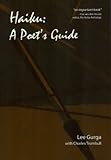Description
Haiku and Senryu: A Simple Guide for All
This highly practical book is a comprehensive, step-by-step guide allowing readers to successfully and painlessly write and publish haiku and senryu-- short, insightful poems about nature, the seasons, and human nature. Haiku and senryu, the latter that is often humorous, capture life's moments and delight and stimulate readers and writers. They are quickly becoming a fad for their brevity and thoughtfulness, and are written in dozens of languages in countries worldwide. People from all walks of life are successful in writing them, and one doesn't need a poetry background to catch on. Haiku and senryu are often seen in a multitude of public places, displayed on public transit, in restaurants, at botanic gardens, stores, art galleries, cultural centers, and libraries, to name a few. And, they are often read to the public in cafes and tea houses to crowds that find them entertaining. Haiku and senryu contests are very popular, too. This book's readers will experience the healing nature of haiku and senryu, poems that are thoughtfully written, using an economy of words. They allow us to grasp life's meaning and truths. Readers will learn everything they need to succeed in writing these poems that are about one to four lines, and learning the nuts and bolts of getting them published. They will see their names in print, and even read them to appreciative audiences. This guide also dispels the many myths about haiku's and senryu's content and style, giving both the basics and finer points of this artful type of writing. Haiku don't have to have a certain number of syllables in each line, but they have about 17 or 18 syllables total. There are hundreds of examples of excellent haiku and senryu included in this fun and instructional book. Ample detailed analysis of poems is provided, so readers can become accustomed to their flow, rhythm, and simple language that evokes beautiful images. Also included, is instruction about haiku and senryu sequences, a series of individual poems with a theme. This guide also provides the fascinating history of haiku and senryu, both in Japan where they originated, and in the U.S. Further, for educators of all levels and workshop leaders, the book contains teaching outlines, lesson and homework plans, and samples of students' poems. Educators of grade school, junior high, high school, college, and adult workshops will gain a wealth of ideas to instruct students. In addition, the book's exhaustive appendices and bibliography will guide readers to dozens of resources worldwide, online and in print, to increase their knowledge of the two forms, and offer publishing, networking, and contest opportunities. The author interviews and quotes many notable haiku poets about how they became interested in reading and writing haiku and senryu, and why they have been enriched personally by pursuing this art. Unlike other books, it gives equal attention to senryu that is similar in style to general haiku, but has a refreshing and unique subtlety to its lightheartedness and humor. This book is jam-packed with information. It is a reference book that readers will refer to frequently for memorable examples of poems and must-read tips on writing and publishing. Each page yields essential and valuable information that readers will highlight and review. This book makes a wonderful gift, too. As Denis Garrison, author of Fire Blossoms: The Birth of Haiku Noir and Editor of Modern English Tanka, recently stated: I highly recommend Haiku and Senryu: A Simple Guide for All. Comprehensive! And, as Donna Bauerly, Professor Emeritus of Loras College, recently stated: Marvelous book! Marvelous insight. I truly enjoyed this book, being wonderfully surprised by new information that I didn't know. The chapter on teaching haiku was especially great, since I've taught it, but by a different method.






